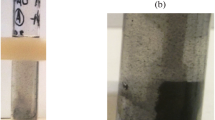Abstract
MIC of metals occurs usually in connection with biofilms and EPS. Especially dangerous are alternating oxygenation conditions aerobic/anaerobic. In case of steel pilings the dimension time has a decisive effect too. A test apparatus for analysis of the resistance of steels against MIC, the mini-plant, has been developed.
Similar content being viewed by others
References
Beech BB & Tapper RC (1999) Exopolymers of SulphateReducing Bacteria. In: Wingender J, Neu TR & Flemming H-C (Eds) Microbial Extracellular Polymeric Substances (pp 119–126). Springer, Berlin Heidelberg
Eul U, von Rège H, Heitz E & Sand W (1996) Simulation and Control of MIC by the Miniplant Technique. In: Heitz E, Flemming H-C & Sand W (Eds) Microbially Influenced Corrosion of Materials (pp 187–203). Springer, Berlin Heidelberg
Gehrke T, Drews M & Sand W (1996) Microbiological Examinations of Low-Water Corrosion on Steel Piling Structures. In: Sand W & Kreysa G (Eds) DECHEMA-phate, Monographie 133, Biodeterioration and Biodegradation (pp 101–106). VCH, Weinheim
Gehrke T, Telegdi J, Thierry D & Sand W (1998) Importance of extracellular polymeric substances from Thiobacillus ferrooxidans for bioleaching. Appl. Environ. Microbiol. 64:2743–2747
Korkhaus J, Titz JT & Wagner GH (1994) Lochfraß an Flußwasser-Rohrleitungen aus hochlegierten austenitischen Stählen durch mikrobielle Aktivität. Mater. Corros. 45:87–95
Lee W, Lewandowski Z, Okabe S, Characklis WG & Avci R (1993a) Corrosion of mild steel underneath aerobic bio lms containing sulfate-reducing bacteria–part I:At low dissolved oxygen concentration. Biofouling 7:197–216
Lee W, Lewandowski Z, Morrison M, Characklis WG, Avci R & Nielsen PH (1993b) Corrosion of mild steel underneath aerobic bio lms containing sulfate-reducing bacteria–part II:At high dissolved oxygen concentration. Biofouling 7: 217–239
Linhardt P (1997) Corrosion of metals in natural waters influenced by maganese oxidizing microorganisms. Int. Biodet. Biodeg. 8:201–210
Renner MHW (1997) Corrosion engineering aspects regarding MIC related failures on stainless steels. In: Corrosion 98, paper no. 285, NACE International, Houston, Texas
Sand W, Gehrke T, Hallmann R & Schippers A (1995) Sulfur chemistry, bio lm, and the (in) direct attack mechanism–a critical evaluation of bacterial leaching. Appl. Microbiol. Bsiotechnol. 43:961–966
Sand W, Gehrke T, Jozsa P-G & Schippers A (1997) Novel Mechanism for Bioleaching of Metal Sul des. In: International Biohydrometallurgy Symposium IBS97 Biomine 97, Conference Proceedings (pp QP2. 1–QP2. 10). Australian Mineral Foundation, Glenside, Australia
von Rège H (1999) Bedeutung von Mikroorganismen des Schwefelkreislaufes für die Korrosion von Metallen. Shaker, Aachen
von Rège H & Sand W (1999) Importance of biogenic ironsulfur compounds for metal-MIC. In: Schmitt G & Schütze M (Eds) Solution of Corrosion Problems in Advanced Technologies (pp 85–88). DECHEMA e. V., Frankfurt
Author information
Authors and Affiliations
Rights and permissions
About this article
Cite this article
Sand, W., Gehrke, T. Microbially Influenced Corrosion of Steel in Aqueous Environments. Re/Views in Environmental Science and Bio/Technology 2, 169–176 (2003). https://doi.org/10.1023/B:RESB.0000040468.88570.4e
Issue Date:
DOI: https://doi.org/10.1023/B:RESB.0000040468.88570.4e




